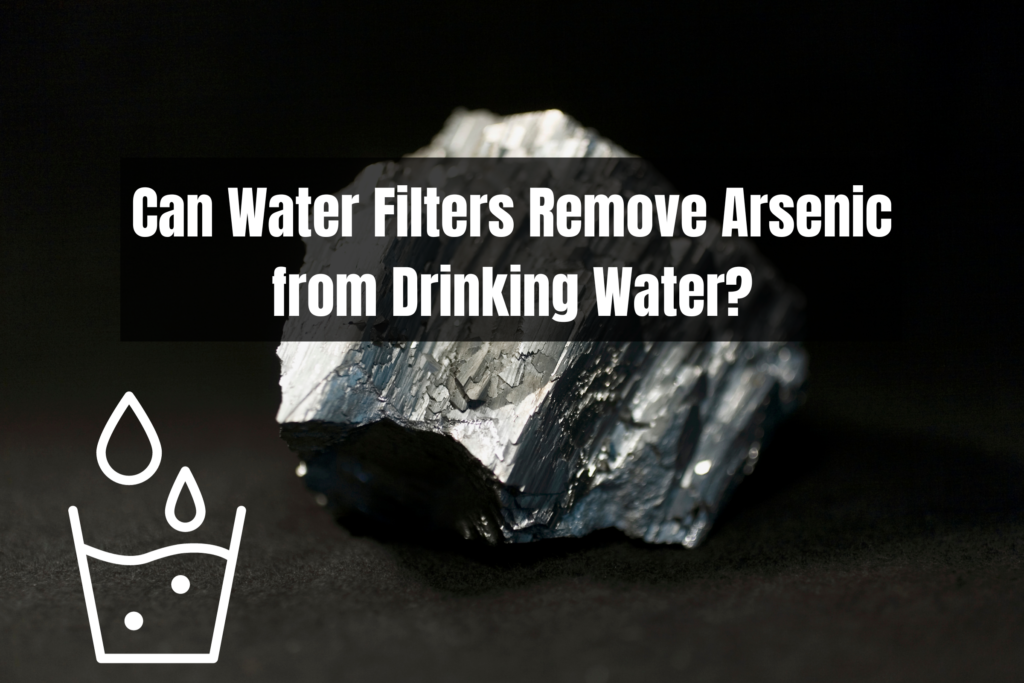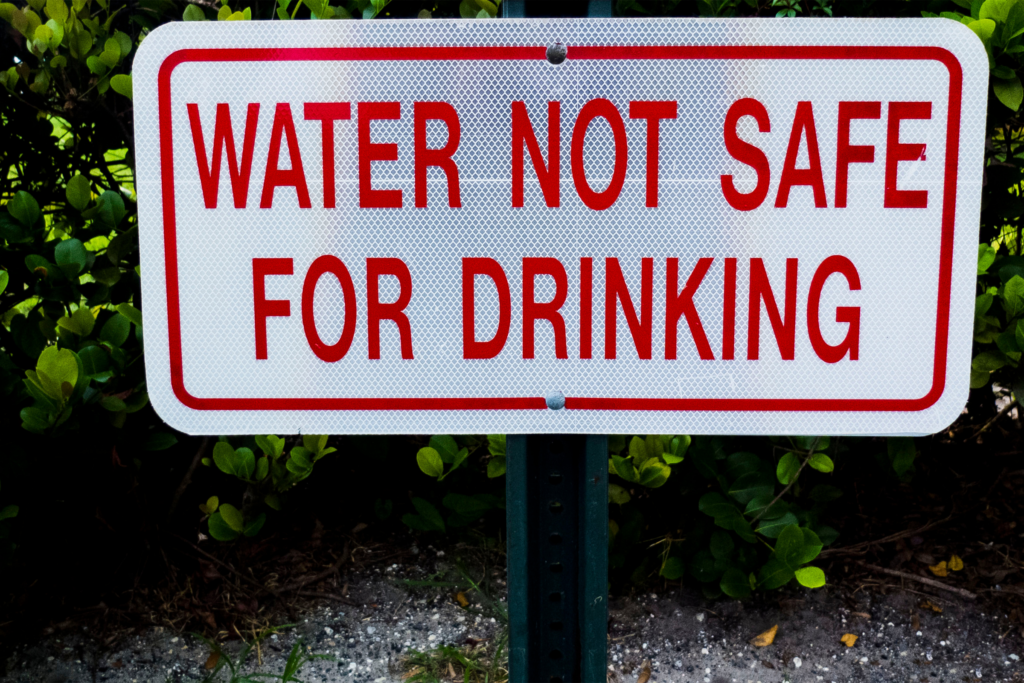Can Water Filters Remove Arsenic from Drinking Water? (+3 Important Factors to Consider)
Arsenic is a naturally occurring metalloid element that is widely distributed in the environment and is the 20th most abundant element in the earth’s crust. It can be found in water, land, air, and living organisms. It is highly toxic to plant, animal, and human life, which explains why we should avoid it.
Occasionally, arsenic can find its way into our water supply. If your water supply has become contaminated with arsenic, you may be wondering, “Can water filters remove arsenic from drinking water?”
Water filters can remove arsenic from drinking water, and inexpensive filters using activated charcoal or reverse osmosis are the most effective and inexpensive solutions. Installing one of these filters on your refrigerator or under your sink is the cheapest and easiest method, but whole-home water filtration systems are the most robust.
Read on to learn more about how arsenic gets into the water supply, potential issues with consuming arsenic, and the best options for you to remove arsenic from your drinking water.

How does arsenic get into water?
Arsenic compounds are present in the air as dust or smoke, as well as in soil. Rain, snow, and surface runoff can cause the arsenic compounds in the air to percolate into the water table.
In addition, arsenic compounds are also naturally released into the soil through the soil formation process, which then percolates with water from rain and surface runoff to groundwater. Commercial wood preservatives, industrial waste, and fertilizers or herbicides used in agriculture also contain arsenic and are usually released in huge quantities into the environment annually.
From these sources, arsenic is leached into groundwater aquifers, rivers, and wells.
What happens if you drink water with arsenic?
Drinking water that contains arsenic is harmful to your health. Exposure to arsenic can cause a change in skin color, kidney failure, skin cancer, skin lesions, hyperkeratosis (formation of hard patches on the palms and soles of the feet), cardiovascular disease, diabetes, impairment of cognitive development, and death.
Early signs of acute arsenic poisoning include pain in the abdomen, nausea, vomiting, diarrhea, numbness, tingling of limbs, and cramping of muscles. Long-term exposure to arsenic may also cause cancers of the bladder and lungs and has been linked to Blackfoot disease, a severe disease of blood vessels that leads to gangrene
How do I know if my water has arsenic in it?
Arsenic is tasteless, colorless, and odorless; therefore, there is no direct physical way of knowing if it is present in water without testing in a laboratory. Also, levels of arsenic can vary greatly, even between wells located in the same area. Therefore, you need to test your well frequently for arsenic to know how much of it is in your drinking water before you can take action.
You should inquire from your county environmental or public health services if they provide water testing services for arsenic or visit an accredited laboratory that will provide you with sample containers and instructions on how to test your water. Whether you detect arsenic in the first test or not, you will still need to repeat the test after about six months to confirm, as research has shown that the levels of arsenic detected may increase or decrease in the first few months after constructing a well.

Is there arsenic in tap water?
The EPA allows 10 micrograms per liter (µg/L*) or 10 parts per billion (ppb) as the maximum level of arsenic that can be contained in community water systems. It has also set its targets on zero levels of arsenic in drinking water since even taking water with much lower levels of arsenic than the recommended levels for many years still increases cancer risk.
However, there are practical obstacles that hinder the removal of arsenic from municipal water supplies and achieving the set standards; thus, tap water usually contains some amounts of this toxic substance.
How much arsenic in drinking water is safe?
Arsenic is one of the chemicals that have been identified as a cause of major public health concerns. Globally, more than 140 million people have been drinking water containing arsenic at levels above the WHO provisional guideline value of .010 mg/L. According to the US National Research Council, as many as 1 in 100 additional cancer deaths could result from lifelong consumption of .005 mg/L or more of arsenic in drinking water.
The Environmental Working Group (EWG) concurs with California’s Public Health Goal (PHG) findings that to lower the lifetime cancer risk to one in a million, arsenic concentrations in water should be below 0.004 ppb.

Can water filters remove arsenic from drinking water?
So, can water filters remove arsenic from drinking water? Arsenic can be fully removed from drinking water through carefully controlled and monitored processes that use activated alumina, ultra-filtration, reverse osmosis, and anion exchange filters. To remove arsenic 3 to a significant extent, it is advisable to use an adsorptive media with pre-oxidation.
Oxidation changes dissolved arsenic ions into solid particles large enough to be filtered out. Ozonation or addition of ozone and chlorination (addition of chlorine) are the two main ways of achieving arsenic 3 oxidation.
Many Point-of-use systems usually employ reverse osmosis together with ultra-filtration and are cheaper than anion exchange and adsorptive media systems, while point-of-entry systems use anion exchange and adsorptive media.
- In anion exchange filters, sodium chloride or potassium chloride is used to displace negatively charged toxic arsenic ions by exchanging them for chloride ions. It is suitable for treating the whole home water supply and removing dissolved minerals with little maintenance.
- Reverse osmosis (RO) filters are more suited for point-of-use removal of arsenic 3 and usually require pre-filtration. Energy is used to push water through a porous membrane which blocks contaminants and allows water to pass through.
- Activated alumina filters and most other adsorptive media filters remove arsenic 3, but are not efficient enough and depend on water pH. They may also require prior treatment of the water to adjust its pH. A bed or membrane containing charged media causes oppositely charged contaminant ions to be pulled out of the water and attached to the adsorbent media.
Factors to consider when choosing the correct filter are:
- The type of arsenic present in the water: arsenic 3 or 5. For example, Arsenic 3 must be oxidized to arsenic 5 using oxidants like liquid chlorine (bleach), hydrogen peroxide, or ozone before it can be removed from the water. Check which type of arsenic you’re dealing with to make sure your water filters remove arsenic from drinking water.
- The type of treatment system you need, either point-of-use (at the tap) or point-of-entry (whole house treatment).
- Other contaminants in the water, like manganese and iron, might need to be removed from the water before the arsenic treatment as they can combine with it and hinder its removal.
Do refrigerator water filters remove arsenic?
Some fridge filters contain arsenic-selective resin specifically designed to reduce arsenic. However, most refrigerators use only carbon filters which will only reduce the amount of arsenic by around 40% to 70%.
A few others use reverse osmosis and a combination of filtration technologies to remove approximately 95% arsenic from water.
Can I shower in arsenic water?
There is no danger in bathing, swimming, brushing teeth, or washing with arsenic water since arsenic is not absorbed through the skin and does not evaporate into the air unless it has concentrations above 500 ppb. A study carried out in Maine, a region known to have a high prevalence of wells with high levels of arsenic, found that bathing was not a significant source of arsenic exposure to children or adults.
Skin uptake or inhalation exposure, which should be directly proportional to the time spent bathing, the number of bathing events, and the concentration of arsenic in water, did not correlate with the amounts of arsenic measured in the urine of young children after bathing, or that of older children and adults after showering with arsenic water.
In very extreme but rare cases, skin irritation, with effects like erythema, swelling (with papules and blisters) as well and contact dermatitis, have been reported after exposure to very high levels (more than 1000 ppb) of radioactive arsenic-73.
Other effects, including pain, lacrimation, blepharospasm, conjunctivitis, photophobia, visual disturbance, and damage to the cornea, may occur after exposure to inorganic arsenic in the eyes.

Does boiling water get rid of arsenic?
No.
Boiling water does not remove arsenic. It actually increases its concentration because as water evaporates during the boiling process, arsenic remains behind. However, distillation, which involves boiling water into steam and then condensing it back to liquid in a separate container, can remove arsenic.
Can arsenic evaporate?
Arsenic does not evaporate but can get into the air when contaminated materials are burned. It settles on the ground from the air after dissolving in rainwater or snowfall. It can then change into different forms by combining with other elements to form compounds that are also soluble in water.
Arsenic also readily combines with oxygen when heated in air to form white arsenic (As4O6), which easily sublimes, and the oxide vapor can be inhaled or condensed on water and other surfaces.

Does arsenic build up in your system?
Yes, repeated or continuous exposure to arsenic compounds causes it to accumulate in the body, leading to chronic arsenic poisoning (arsenicosis). However, this build-up does not continue when the consumption of arsenic water is stopped.
It can be excreted through pee and poo after stopping intake. Some of it also gets deposited on hair and nails and is removed as they grow.
How long does it take for arsenic to leave the body?
Urine tests that show levels above .005 to .01 mg/L after 24 hours or spot checks that reveal levels greater than .0035 to .005 mg/L are normally evidence of acute arsenic poisoning. Testing for arsenic in the blood is not so useful since it gets cleared within a few hours from serum.
This is because arsenic has a high affinity for tissue proteins and is treated by the body like phosphates, thus it gets incorporated into phosphate areas and excreted at the same rate, with an excretion half-life of 12 days.
The toxic inorganic forms of arsenic, As(5+) or As(V), and the more toxic As(3+) or As(III), are usually detoxified in the liver, where As(3+) is oxidized to As(5+) and then methylated into monomethylarsine (MMA) and dimethylamine (DMA). Because of this, As(3+) and As(5+) appear in urine within a short time after being consumed, while MMA and DMA persist longer than 24 hours.
The half-life of inorganic arsenic in the blood is 4 to 6 hours, and the half-life of the methylated organic metabolites is 20 to 30 hours. For this reason, you need to make sure your water filters remove arsenic from drinking water.
What organs are affected by arsenic?
Arsenic mainly targets the gastrointestinal tract, heart, brain, reproductive organs, and kidneys after being absorbed into the body and may lead to multiple organ failures.
It also affects the skin, mucous membranes, eyes, lungs, bone marrow, and peripheral nervous system.

Does arsenic in water cause hair loss?
Although there are many varied reasons why a person can experience hair loss (alopecia), arsenic is one of the poisonous chemicals that have been associated with it. Prolonged consumption of water that contains arsenic results in poisoning, which is often evidenced by hair loss. Its organic forms, MMA and DMA, tend to be more readily absorbed into the body and removed much more slowly; they are more toxic in the long run than the inorganic species, which are expelled faster.
Arsenic binds to protein by forming a covalent complex with sulfhydryl groups of the amino acid cysteine. But a lot of cysteine residues are also found in keratin, which is the major structural protein in hair and nails. Thus hair is one of the major sites for accumulation of arsenic than in other tissue.
While the exact mechanism for hair fall as a result of arsenic poisoning is not yet clear, it is thought that oxidative stress and interaction of Wnt protein (secreted, lipid-modified glycoproteins that allow for communication between cells) initiate further downstream pathways to reduce hair tone.
Arsenic often blocks the binding of T-cell factor (TCF) with DNA and facilitates the production of free radicals, which initiates the expression of various inflammatory cytokines that lead to hair fall. This is why it’s crucial that your water filters remove arsenic from drinking water.
Summary of Can water filters remove arsenic from drinking water?
In short, arsenic is bad for you. Drinking water containing arsenic continuously is one sure way of inviting serious health complications. The first step is to test your water to know for sure if your water has arsenic and if the levels are dangerous or acceptable.
Once you do, you can invest in a water filter that is best suited for arsenic removal. We recommend the Apex Legends Whole House water filtration system because it eliminates arsenic from water. It also takes care of fluoride, chlorine, and tens of other common contaminants. Based on all of the information above, it’s clearly important to make sure your water filters remove arsenic from drinking water.
What are some of the risks of arsenic in drinking water?
Arsenic exposure in drinking water can lead to hair loss, organ failure, diabetes, and more if left unchecked over time. For this reason, it’s important to learn how water filters remove arsenic from drinking water.
What are the best arsenic removal systems?
A membrane filter with activated charcoal is a great system for arsenic removal. Many types of water filters remove arsenic from drinking water, including the reverse osmosis system as well.
How do you operate and maintain an arsenic removal system?
Make sure you clean the filters of your system from time to time, and ensure none of the component parts have worn out. When water filters remove arsenic from drinking water, they don’t usually require a lot of maintenance.
What are the best filters to remove arsenic?
Many types of water filters remove arsenic from drinking water, including the reverse osmosis system and membrane filters with activated charcoal.
Let Us Know How We’re Doing!
Did this expertly prepared resource answer your question?
Do you have another question about home maintenance, home improvement projects, home appliance repair, or something else?
Get more information, send in questions and keep the discussion going by contacting the I’ll Just Fix It Myself company customer service team at at 1-800-928-1490 or Email us at [email protected]
